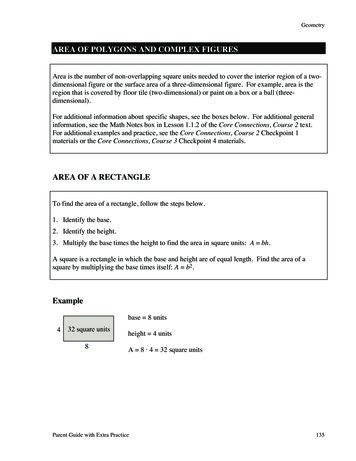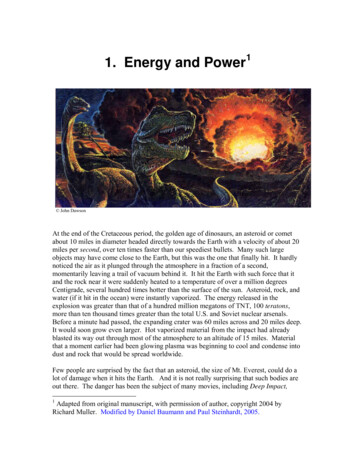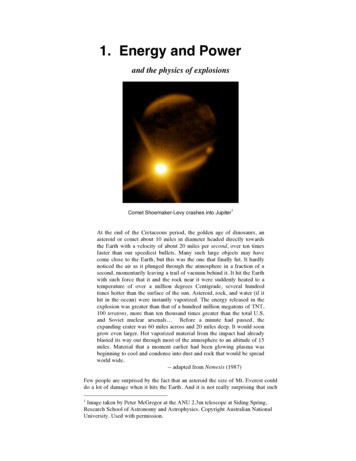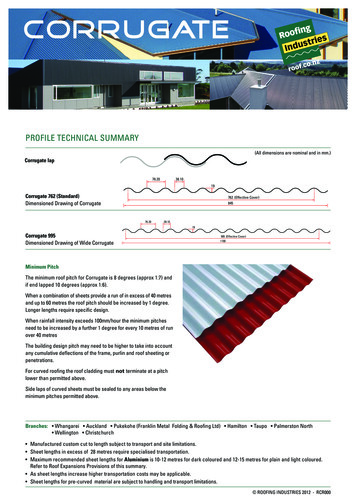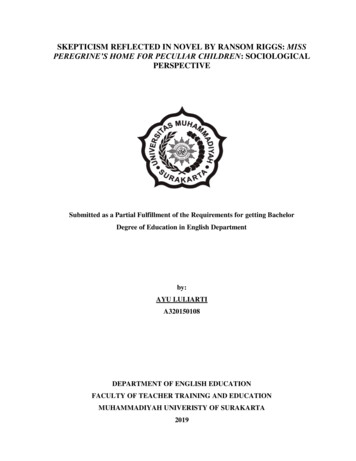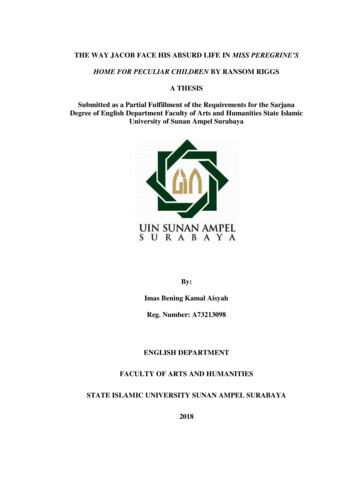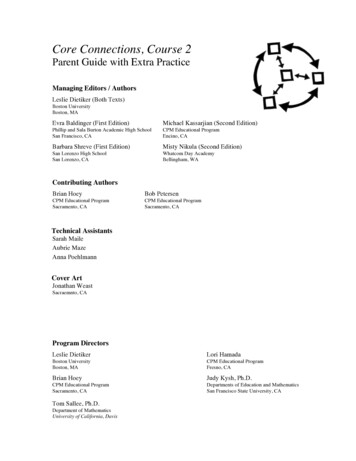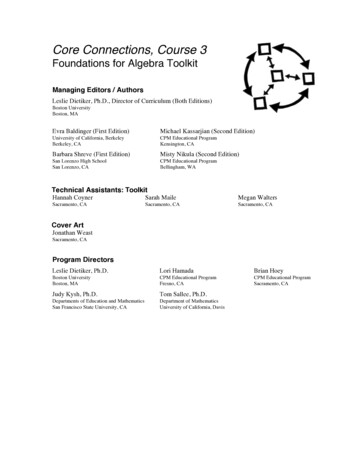
Transcription
Core Connections, Course 3Foundations for Algebra ToolkitManaging Editors / AuthorsLeslie Dietiker, Ph.D., Director of Curriculum (Both Editions)Boston UniversityBoston, MAEvra Baldinger (First Edition)Michael Kassarjian (Second Edition)University of California, BerkeleyBerkeley, CACPM Educational ProgramKensington, CABarbara Shreve (First Edition)Misty Nikula (Second Edition)San Lorenzo High SchoolSan Lorenzo, CACPM Educational ProgramBellingham, WATechnical Assistants: ToolkitHannah CoynerSarah MaileMegan WaltersSacramento, CASacramento, CASacramento, CACover ArtJonathan WeastSacramento, CAProgram DirectorsLeslie Dietiker, Ph.D.Lori HamadaBrian HoeyBoston UniversityBoston, MACPM Educational ProgramFresno, CACPM Educational ProgramSacramento, CAJudy Kysh, Ph.D.Tom Sallee, Ph.D.Departments of Education and MathematicsSan Francisco State University, CADepartment of MathematicsUniversity of California, Davis
Copyright 2013 by CPM Educational Program. All rights reserved. No part of thispublication may be reproduced or transmitted in any form or by any means, electronic ormechanical, including photocopy, recording, or any information storage and retrieval system,without permission in writing from the publisher. Requests for permission should be made inwriting to: CPM Educational Program, 9498 Little Rapids Way, Elk Grove, CA 95758.Email: cpm@cpm.org.1 2 3 4 5 616 15 14 13 12 11 10Printed in the United States of AmericaISBN: 978-1-60328-096-9
Core Connections: Foundations for AlgebraCourse 3 ToolkitChapter 1 Problem SolvingLearning Log Entries1.2.1Fraction Decimal PercentAxes, Quadrants, and Graphing on an xy-Coordinate GraphWriting Equations Using the 5-D ProcessProportional RelationshipsSolving ProportionsChapter 2 Simplifying with VariablesLearning Log Algebra Tiles and VariablesFinding Perimeter and Combining Like TermsMeanings of MinusRepresenting Expressions on an Expression MapUsing Zeros to SimplifyLegal Moves for Simplifying and Comparing ExpressionsSolutions of an EquationMath 2Proportional RelationshipsMath hematics VocabularyCombining Like TermsEvaluating Expressions and the Orders of OperationsCommutative PropertySimplifying an Expression (“Legal Moves”)Associative and Identity PropertiesInverse PropertiesUsing an Equation Mat17171718192020212122
Chapter 3 Graphs and EquationsLearning Log Entries3.1.63.1.73.2.2Patterns in NatureDiscrete and Continuous GraphsParabolasIndependent and Dependent VariablesComplete GraphCircular Vocabulary, Circumference, and AreaSolving a Linear EquationSolutions to an Equation with One VariableThe Distributive PropertyChapter 4 Multiple RepresentationsLearning Log Entries4.1.24.1.34.1.44.1.6Representations of PatternsChapter 5 Systems of EquationsLearning Log 38Solving Equations with FractionsPoints of IntersectionEqual Values MethodMath ns of Patterns WebConnecting Linear Rules and Graphsy mx bGraphing Without an x y TableMath Notes4.1.723Qualities of a Complete GraphGraphing ErrorsHow Many Solutions?Math 23Linear EquationsEquivalent EquationsSolving Equations with Fractions (also known as the Fraction Buster Method)System of Equations VocabularyThe Equal Values MethodSolutions to a System of Equations41414142424343
Chapter 6 Transformations and SimilarityLearning Log Entries6.1.36.2.16.2.36.2.6Rigid TransformationsCorresponding Parts of Similar ShapesScale FactorChapter 7 Slope and AssociationLearning Log Entries7.1.37.2.37.3.17.3.2Circle GraphsLine of Best FitDescribing Association – Part 1Slope of a LineProportional EquationsDescribing Association – Part 2Chapter 8 Exponents and FunctionsLearning Log 06161Simple and Compound InterestScientific NotationSimplifying Exponent ExpressionsFunctionsMath lope and SteepnessLine From Data PointsDescribing AssociationMath Notes7.1.17.1.27.1.37.2.47.2.57.3.244Rigid TransformationsDilationsFinding Similar ShapesFinding Missing Sides of Similar ShapesMath Notes6.1.36.2.26.2.644Simple InterestExponentsCompound InterestScientific NotationLaws of ExponentsFunctions66666667676868
Chapter 9 Angles and the Pythagorean TheoremLearning Log Entries9.1.19.1.29.1.49.2.19.2.39.2.5Angle VocabularyParallel Lines and Angle PairsAngle Sum Theorem for TrianglesExterior Angle Theorem for TrianglesAA Similarity for TrianglesTriangle Inequality and Side Length PatternsRight Triangles and the Pythagorean TheoremThe Real-Number SystemSquaring and Square RootsChapter 10 Surface Area and VolumeLearning Log 8081818282Cube RootsSurface Area and Volume of a CylinderVolumes of Cones and PyramidsVolume of a SphereMath Notes10.1.210.1.310.1.410.1.569Angle RelationshipsAngles in a TriangleAngle-Angle SimilarityTriangle InequalitySquare RootsPythagorean TheoremMath 69Volume of a CylinderSurface Area of a CylinderVolume of a Pyramid and a ConeVolume of a Sphere878787888889
Dear Math Student,Welcome to your Core Connections: Foundations for AlgebraToolkit! It is designed to help you as you learn math throughoutthe school year. Inside, you will find all of the Math Notes fromyour textbook that have useful information about the topics youwill study. You will also be able to write in your Toolkit so thatyou can keep track of what you have learned in your own wordsand refer back to those notes as you move forward.Many lessons in your math book include a prompt that asks you to think and write about thetopic you are learning that day in a Learning Log. There is space in this Toolkit to write yourLearning Log entries so that they are all in one place and are easy to use later. It is a good ideato leave some space between your entries so that you can add new ideas to them later, as youlearn more. Note that this space has a light grid, which you can use like lined paper, as well as tohelp you draw diagrams or graphs.Throughout the year, remember to make notes in your Toolkit and add examples if you find themhelpful. It is important that the information on these pages—especially the Math Notes—makessense to you, so be sure to highlight key information, write down important things to remember,and ask questions if something does not make sense.Also remember that the information in your Toolkit can help you solve problems and keep trackof important vocabulary words. Keep your Toolkit with you when you are working on mathproblems, and use it as a source of information as you move through the course.At the end of each chapter in your textbook, there are lists of all of the Learning Log entries andMath Notes for that chapter. There are also lists of important vocabulary words. Take time asyou complete each chapter to look through your Toolkit and make sure it is complete. Updatingyour Toolkit regularly and using it when you are studying are important student habits that willhelp you to be successful in this and future courses.Have a wonderful year of learning!The CPM Team
C HAPTER 1: P ROBLEM S OLVINGDate:Lesson:2Learning Log Title:Core Connections, Course 3
Chapter 1: Problem SolvingDate:Lesson:ToolkitLearning Log Title:3
Notes:MATH NOTESFRACTION DECIMAL PERCENTThe Representations of a Portion web diagram at right illustrates thatfractions, decimals, and percents are different ways to represent a portion ofa number. Portions can also be represented in words, such as “four fifths”or “twelve-fifteenths” or with diagrams.fractionwords orpicturesdecimalpercentRepresentations of a PortionThe examples below show how to convert from one form to another.4Decimal to percent:Multiply the decimal by 100.(0.34)(100) 34%Percent to decimal:Divide the percent by 100.78.6% 78.6 100 0.786Fraction to percent:Set up an equivalent fractionusing 100 as the denominator.The numerator is the percent.Percent to fraction:Use 100 as the denominator. Usethe number in the percent as thenumerator. Simplify as needed.Decimal to fraction:Use the digits as the numerator.Use the decimal place value as thedenominator. Simplify as needed.Fraction to decimal:Divide the numerator by thedenominator.Core Connections, Course 3
Chapter 1: Problem SolvingAXES, QUADRANTS, ANDGRAPHING ON ANXY-COORDINATE GRAPHNotes:Coordinate axes on a flat surface are formed by drawing vertical andhorizontal number lines that meet at 0 on each number line and form a rightangle (90 ). The x- and y-axes help define points on a graph (called a“Cartesian Plane”). The x-axis is horizontal, while the y-axis is vertical.The x- and y-axes divide the graphing area into four sections calledquadrants.Numerical data can be graphed on a planeusing points. Points on the graph areidentified by two numbers in an orderedpair written as (x, y) . The first number isthe x-coordinate of the point, and thesecond number is the y-coordinate. Thepoint (0, 0) is called the origin.To locate the point (3, 2) on anxy-coordinate graph, go three units fromthe origin to the right to 3 on thehorizontal axis and then, from that point,go 2 units up (using the y-axis scale). Tolocate the point (!2, !4) , go 2 units fromthe origin to the left to !2 on thehorizontal axis and then 4 units down(using the y-axis scale).Toolkit4-quadrant graph:y-axisII1st-quadrant 21–4 –3 –2 –1–1–2–3–4x-coordinate(3, 2)ordered pair1 2 3 4 x-axis(0, 0)(origin)5
Notes:WRITING EQUATIONS USINGTHE 5-D PROCESSThe 5-D Process is an organized method to help write equations andsolve problems. The D’s stand for Describe/Draw, Define, Do,Decide, and Declare. An example of this work is shown below.Example Problem: The base of a rectangle is 13 centimeters longer thanthe height. If the perimeter is 58 centimeters, find the base and the height ofthe rectangle.heightDescribe/Draw: The shape is a rectangle, andwe are looking at the perimeter.DefineHeight(trial)Trial 1: 10Base(height 13)baseDoDecidePerimeter2(base) 2(height)5866 is toohigh10 13 232(23) 2(10) 66Use any trialvalue.Use the relationships stated in theproblem to determine the values ofthe other quantities (such as baseand perimeter).Let x represent xthe height incmNow use your algebraskills to solve theequation.x 132(x) 2(x 13)Now use the trial tocreate an equationby defining andadding a variableline.2(x) 2(x 13) 58Declare: The base is 21 centimeters, and the height is 8 centimetersIf you do not write an equation, you can solve the problem by making moretrials until you find the answer.6Core Connections, Course 3
Chapter 1: Problem SolvingPROPORTIONAL RELATIONSHIPSNotes:A proportional relationship can be seen in a table: if onequantity is multiplied by an amount, the corresponding quantityis multiplied by the same amount. On a graph, a proportionalrelationship is linear and goes through the origin.Pounds036912Cost ( )07142128Cost ( )Proportional example: Three pounds of chicken costs 7.00.Below, other values are shown in the table and plotted on the graph.20102 4 6 8 10 12PoundsGames01234( )8Cost ( )56789CostThe relationship between poundsand cost is proportional.4Non-proportional example: The videoarcade costs 5.00 to enter and 1.00 per game.1 2 3 4 5 6GamesThe relationship between games and cost is not proportional. Forexample, someone who plays four games ( 9) does not pay twice asmuch as someone who played two games ( 7). There is no multiplierfor the relationship. The graph does not go through the origin.Toolkit7
Notes:SOLVING PROPORTIONSIf a relationship is known to be proportional, ratios from thesituation are equal. An equation stating that two ratios areequal is called a proportion. Some examples of proportionsare:57 50706!mi2!hr 9!mi3!hrSetting up a proportion is one strategy for solving for an unknown part ofone ratio. For example, if the ratios 92 and 16x are equal, setting up theproportion 16x 92 allows you to solve for x.Giant One: One way to solvethis proportion is by using aGiant One to find the equivalentratio. In this case, since 16 is 2times 8, you create the Giant Oneshown at right.x16 92 !!!!! 88x16 9!82!8x16 7216which shows that x 72.Undoing Division: Another way to solve thex as, “ x dividedproportion is to think of the ratio 16by 16.” To solve for x, use the inverse operation ofdivision, which is multiplication. Multiplying bothsides of the proportional equation by 16 “undoes” thedivision.( )161x16 92x16 92x ( )1611442x 72Cross-Multiplication: This method of solving the proportion is a shortcutfor using a Fraction Buster (multiplying each side of the equation by thedenominators).Fraction Buster 922 !16 ! 16x 92x168Cross-Multiplicationx16! 2 !16 92x!! !! 92162 ! x 9 !162 ! x 9 !162x 1442x 144x 72x 72Core Connections, Course 3
Chapter 2: Simplifying With VariablesC HAPTER 2: S IMPLIFYING W ITH V ARIABLESDate:Lesson:ToolkitLearning Log Title:9
Date:Lesson:10Learning Log Title:Core Connections, Course 3
Chapter 2: Simplifying With VariablesDate:Lesson:ToolkitLearning Log Title:11
Date:Lesson:12Learning Log Title:Core Connections, Course 3
Chapter 2: Simplifying With VariablesDate:Lesson:ToolkitLearning Log Title:13
Date:Lesson:14Learning Log Title:Core Connections, Course 3
Chapter 2: Simplifying With VariablesDate:Lesson:ToolkitLearning Log Title:15
Date:Lesson:16Learning Log Title:Core Connections, Course 3
Chapter 2: Simplifying With VariablesMATH NOTESNotes:NON-COMMENSURATETwo measurements are called non-commensurateif no combination of one measurement can equal acombination of the other. For example, your algebratiles are called non-commensurate because no combination ofunit squares will ever be exactly equal to a combination of x-tiles(although at times they may appear close in comparison). In the sameway, in the example below, no combination of x-tiles will ever be exactlyequal to a combination of y-tiles.xxyxxyyNo matter what number of each sizetile, these two piles will never exactlymatch.MATHEMATICS VOCABULARYVariable: A letter or symbol that represents one or more numbers.Expression: A combination of numbers, variables, and operation symbols.For example, 2x 3(5 – 2x) 8. Also, 5 – 2x is a smaller expression withinthe larger expression.Term: Parts of the expression separated by addition and subtraction.For example, in the expression 2x 3(5 – 2x) 8, the three terms are 2x,3(5 – 2x), and 8. The expression 5 – 2x has two terms, 5 and –2x.Coefficient: The numerical part of a term. In the expression2x 3(5 – 2x) 8, for example, 2 is the coefficient of 2x.In the expression 7x – 15x2, both 7 and 15 are coefficients.Constant term: A number that is not multiplied by a variable.In the expression 2x 3(5 – 2x) 8, the number 8 is a constant term.The number 3 is not a constant term, because it is multiplied by a variableinside the parentheses.Factor: Part of a multiplication expression. In the expression 3(5 – 2x),3 and 5 – 2x are factors.Toolkit17
Notes:COMBINING LIKE TERMSCombining tiles that have the same area to write a simplerexpression is called combining like terms. See the exampleshown at right.When you are not working with actual tiles, it can help to picture the tiles inyour mind. You can use these images to combine the terms that are thesame. Here are two examples:xxExample 1:2x 2 xy y 2 x 3 x 2 3xy 2 ! 3x 2 4 xy y 2 x 5Example 2:3x 2 ! 2x 7 ! 5x 2 3x ! 2 ! !2x 2 x 5A term is an algebraic expression that is a single number, a single variable,or the product of numbers and variables. The simplified algebraicexpression in Example 2 above contains three terms. The first term is!2x 2 , the second term is x, and the third term is 5.18Core Connections, Course 3
Chapter 2: Simplifying With VariablesEVALUATING EXPRESSIONSAND THE ORDER OF OPERATIONSNotes:To evaluate an algebraic expression for particular values of thevariables, replace the variables in the expression with their knownnumerical values and simplify. Replacing variables with their knownvalues is called substitution. An example is provided below.Evaluateforand.Replace x and y with their known values of 2 and 1, respectively, andsimplify.When evaluating a complex expression, you must remember to use theOrder of Operations that mathematicians have agreed upon. As illustratedin the example below, the order of operations is:Original expression:Circle expressions that are grouped withinparentheses or by a fraction bar:Simplify within circled terms using the orderof operations: Evaluate exponents. Multiply and divide from left to right. Combine terms by adding and subtractingfrom left to right.Circle the remaining terms:Simplify within circled terms using the Orderof Operations as described above.Toolkit19
Notes:COMMUTATIVE PROPERTIESThe Commutative Property of Addition states that whenadding two or more number or terms together, order is notimportant. That is:a b b a.For example, 2 7 7 2The Commutative Property of Multiplication states that whenmultiplying two or more numbers or terms together, order is not important.That is:a!b b!a .For example, 3!·!5 5!·!3However, subtraction and division are not commutative, as shown below.7 ! 2 " 2 ! 7 since 5 ! "550 10 ! 10 50 since 5 ! 0.2SIMPLIFYING AN EXPRESSION(“LEGAL MOVES”)Three common ways to simplify or alter expressions onan Expression Mat are illustrated below. Removing an equal number of oppositetiles that are in the same region. Forexample, the positive and negative tiles inthe same region at right combine to makezero. – Flipping a tile to move it out of one regioninto the opposite region (i.e., finding itsopposite). For example, the tiles in the “–” region at right can be flipped into the“ ” region. Removing an equal number of identical tilesfrom both the “–” and the “ ” regions. Thisstrategy can be seen as a combination of thetwo methods above, since you could first flipthe tiles from one region to another and thenremove the opposite pairs. – –20Core Connections, Course 3
Chapter 2: Simplifying With VariablesASSOCIATIVE AND IDENTITYPROPERTIESNotes:The Associative Property of Addition states that when adding threeor more number or terms together, grouping is not important. That is:(a b) c a (b c)For example, (5 2) 6 5 (2 6)The Associative Property of Multiplication states that when multiplyingthree or more numbers or terms together, grouping is not important. Thatis:(a ! b) ! c a ! (b ! c)For example, (5!·!2)!·!6 5!·!(2!·!6)However, subtraction and division are not associative, as shown below.(5 ! 2) ! 3 " 5 ! (2 ! 3) since 0 ! 6(20 4) 2 ! 20 (4 2) since 2.5 ! 10The Identity Property of Addition states that adding zero to anyexpression gives the same expression. That is:a 0 aFor example, 6 0 6The Identity Property of Multiplication states that multiplying anyexpression by one gives the same expression. That is:1! a aFor example, 1!·!6 6INVERSE PROPERTIESThe Additive Inverse Property states that for every number athere is a number –a such that a (!a) 0 . A common nameused for the additive inverse is the opposite. That is, –a is theopposite of a. For example, 3 (!3) 0 and !5 5 0 .The Multiplicative Inverse Property states that for every nonzero numbera there is a number 1a such that a ! 1a 1 A common name used for themultiplicative inverse is the reciprocal. That is, 1a is the reciprocal of a.For example, 6 ! 16 1 .Toolkit21
Notes:USING AN EQUATION MATAn Equation Mat can helpyou visually represent anequation with algebra tiles.The double linerepresents the “equal”sign ( ). For each side of the equation,there is a positive and anegative region.For example, the equation 2x ! 1 ! (! x 3) 6 ! 2x can be represented bythe Equation Mat at right. (Note that there are other possible ways torepresent this equation correctly on the Equation Mat.) x22 xxxx 1 –1Core Connections, Course 3
Chapter 3: Graphs and EquationsC HAPTER 3: G RAPHS AND E QUATIONSDate:Lesson:ToolkitLearning Log Title:23
Date:Lesson:24Learning Log Title:Core Connections, Course 3
Chapter 3: Graphs and EquationsDate:Lesson:ToolkitLearning Log Title:25
Notes:MATH NOTESPATTERNS IN NATUREPatterns are everywhere, especially in nature. One famous patternthat appears often is called the Fibonacci Sequence, a sequence ofnumbers that starts 1, 1, 2, 3, 5, 8, 13, 21, The Fibonacci numbers appear in many different situations in nature. Forexample, the number of petals on a flower is often a Fibonacci number, andthe number of seeds on a spiral from the center of a sunflower is, too.To learn more about Fibonacci numbers, search the Internet or check out abook from your local library. The next time you look at a flower, look forFibonacci numbers!When a graph of data is limited to a set ofseparate, non-connected points, thatrelationship is called discrete. For example,consider the relationship between thenumber of bicycles parked at your schooland the number of bicycle wheels. If thereis one bicycle, it has two wheels. Twobicycles have four wheels, while threebicycles have six wheels. However, therecannot be 1.3 or 2.9 bicycles. Therefore,this data is limited because the number ofbicycles must be a whole number, such as 0,1, 2, 3, and so on.Number ofWheelsDISCRETE GRAPHS64Discretegraph22 4 6Number ofBicyclesWhen graphed, a discrete relationship looks like a collection of unconnectedpoints. See the example of a discrete graph above.26Core Connections, Course 3
Chapter 3: Graphs and EquationsCONTINUOUS GRAPHSHeight of Tree (feet)When a set of data is not confined toseparate points and instead consists ofconnected points, the data is calledcontinuous. “John’s Giant Redwood,”problem 3-11, is an example of acontinuous situation, because even thoughthe table focuses on integer values ofyears (1, 2, 3, etc.), the tree still growsbetween these values of time. Therefore,the tree has a height at any non-negativevalue of time (such as 1.1 years after it isplanted).Notes:302010Continuousgraph2 4 6Number of YearsAfter PlantedWhen data for a continuous relationship are graphed, the points areconnected to show that the relationship also holds true for all pointsbetween the table values. See the example of a continuous graph above.Note: In this course, tile patterns will represent elements of continuousrelationships and will be graphed with a continuous line or curve.PARABOLASOne kind of graph youwill study in this class iscalled a parabola. Twoexamples of parabolas aregraphed at right. Note thatparabolas are smooth “U”shapes, not pointy “V”shapes.yyvertexxxThe point where a parabola turns (the highest or lowest point) is called thevertex.Toolkit27
Notes:INDEPENDENT ANDDEPENDENT VARIABLESWhen one quantity (such as the height of a redwood tree) depends onanother (such as the number of years after the tree was planted), it is calleda dependent variable. That means its value is determined by the value ofanother variable. The dependent variable is usually graphed on the y-axis.If a quantity, such as time, does not depend on another variable, it isreferred to as the independent variable, which is graphed on the x-axis.yFor example, in problem 3-46, you compared theamount of a dinner bill with the amount of a tip.In this case, the tip depends on the amount of thedinner bill. Therefore, the tip is the dependentvariable, while the dinner bill is the riablexCOMPLETE GRAPHA complete graph has the following components: x-axis and y-axis labeled, clearly showing the scale. Equation of the graph near the line or curve. Line or curve extended as far as possible on the graph.Coordinates of special points stated in (x, y) format.Tables can be formattedhorizontally, like the oneat right, or vertically, asshown pt(0, 4)43–232–4 –3 –2 –1–1Origin(0, 0)4–4The graph ofy –2x 4x-intercept(2, 0)1Throughout this course, you will continueto graph lines and other curves. Be sureto label your graphs appropriately.2812–21234 x(3, –2)–3–4Core Connections, Course 3
Chapter 3: Graphs and EquationsCIRCULAR VOCABULARY,CIRCUMFERENCE, AND AREANotes:radiusThe radius of a circle is a line segment from itscenter to any point on the circle. The term isalso used for the length of these segments. Morethan one radius are called radii.diameterchordA chord of a circle is a line segment joining any two points on a circle.A diameter of a circle is a chord that goes through its center. The term isalso used for the length of these chords. The length of a diameter is twicethe length of a radius.The circumference (C) of a circle is its perimeter, or the“distance around” the circle.C ! "ddThe number π (read “pi”) is the ratio of the circumferenceof a circle to its diameter. That is, ! circumference. Thisdiameterdefinition is also used as a way of computing thecircumference of a circle if you know thediameter, as in the formula C ! d where C is the circumference andd is the diameter. Since the diameter is twice the radius ( d 2r ), theformula for the circumference of a circle using its radius is C ! (2r) orC 2! " r .The first few digits of π are 3.141592.To find the area (A) of a circle when given its radius (r), square the radiusand multiply by π. This formula can be written as A r 2 ! " . Anotherway the area formula is often written is A ! " r 2 .Toolkit29
Notes:SOLVING A LINEAR EQUATIONWhen solving an equation like the one shown below, severalimportant strategies are involved. Simplify. Combine like terms and“make zeros” on each side of theequation whenever possible. Keep equations balanced. Theequal sign in an equation indicatesthat the expressions on the left andright are balanced. Anything doneto the equation must keep thatbalance.3x ! 2 4 x ! 63x 2 x ! 6!x !x2x 2 !6!2 !2 Get x alone. Isolate the variable on oneside of the equation and the constants onthe other.2x !8 22x !4combine like termssubtract x onboth sidessubtract 2 onboth sidesdivide bothsides by 2 Undo operations. Use the fact that addition is the opposite of subtractionand that multiplication is the opposite of division to solve for x. Forexample, in the equation 2x –8, since the 2 and x are multiplied,dividing both sides by 2 will get x alone.SOLUTIONS TO AN EQUATIONWITH ONE VARIABLEA solution to an equation gives avalue of the variable that makes theequation true. For example, when 5 issubstituted for x in the equation atright, both sides of the equation areequal. Sois a solution to thisequation.An equation can have more than onesolution, or it may have no solution.Consider the examples at right.Notice that no matter what the value ofx is, the left side of the first equationwill never equal the right side.Therefore, you say thathas no solution.However, in the equation, no matter what value x has, theequation will always be true. Allnumbers can maketrue.Therefore, you say the solution for theequationis all numbers.30Equation with nosolution:Equation with infinitesolutions:Core Connections, Course 3
Chapter 3: Graphs and EquationsT HE D ISTRIBUTIVEP ROPERTYNotes:The Distributive Property states that for any threeterms a, b, and c:a(b c) ab acThat is, when a multiplies a group of terms, such as (b c), it multiplieseach term of the group. For example, when multiplying 2(x 4) , the 2multiplies both the x and the 4. This can be represented with algebra tiles,as shown below.xx2(x 4) 2 ! x 2 ! 4 2x 8The 2 multiplies each term.Toolkit31
C HAPTER 4: M ULTIPLE R EPRESENTATIONSDate:Lesson:32Learning Log Title:Core Connections, Course 3
Chapter 4: Multiple RepresentationsDate:Lesson:ToolkitLearning Log Title:33
Date:Lesson:34Learning Log Title:Core Connections, Course 3
Chapter 4: Multiple RepresentationsDate:Lesson:ToolkitLearning Log Title:35
Date:Lesson:36Learning Log Title:Core Connections, Course 3
Chapter 4: Multiple RepresentationsMATH NOTESNotes:REPRESENTATIONS OF PATTERNSConsider the tile patterns below. The number of tiles in eachfigure can also be represented in an x y table, on a graph, orwith a rule (equation).Remember that in this course, tile patternswill be considered to be elements ofcontinuous relationships and thus will begraphed with a continuous line or curve.TableRuleGraphPatternFigure 0Figure 1Figure 2GraphTile PatternFigure Number (x)Number of Tiles (y)Rule (Equation)Toolkit031527x y Table37
C HAPTER 5: S YSTEMS OF E QUATIONSDate:Lesson:38Learning Log Title:Core Connections, Course 3
Chapter 5: Systems of EquationsDate:Lesson:ToolkitLearning Log Title:39
Date:Lesson:40Learning Log Title:Core Connections, Course 3
Chapter 5: Systems of EquationsMATH NOTESNotes:LINEAR EQUATIONSA linear equation is an equation that forms a line when it is graphed.This type of equation may be written in several different forms.Although these forms look different, they are equivalent; that is, theyall graph the same line.Standard form: An equation in ax by c form, such as !6x 3y 18 .y mx b form: An equation in y mx b form, such as y 2x 6 .yYou can quickly find the growthfactor and y-intercept of a line iny mx b form. For the equationy 2x ! 6 , the growth factor is 2 ,while the y-intercept is (0, –6).2y-intercept–515xgrowthfactory 2x ! 6growth factory-intercept.EQUIVALENT EQUATIONSTwo equations are equivalent if they have all the samesolutions. There are many ways to change one equation into adifferent, equivalent equation. Common ways include: addingthe same number to both
Course 3 Toolkit Chapter 1 Problem Solving 2 Learning Log Entries 2 1.2.1 Proportional Relationships Math Notes 4 1.1.1 Fraction Decimal Percent 4 . Many lessons in your math book include a prompt that asks you to think and write about the topic you are learning that day in a L

